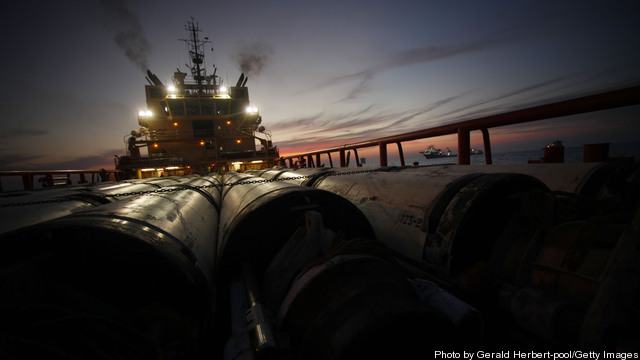North America has seen its share of oil spills of late, including an ExxonMobil pipeline leak in Arkansas and a Chevron diesel pipeline leak in Utah, both within the first few months of the year. Canadian Pacific Railway is keeping the trend going. A Canadian Pacific-operated train carrying crude oil from Saskatchewan derailed on Tuesday,… Keep reading →
Chevron
Sign up and get Breaking Energy news in your inbox.
We will never sell or share your information without your consent. See our privacy policy.
Moody’s analysts are have weighed in on prospects for liquefied natural gas (LNG) exports from the US, forecasting that chemical companies and utilities could see some negative impact from higher domestic natural gas prices, but not enough to bring down their credit ratings.
Moody’s expects US LNG export capacity to rise to 6.3 billion cubic feet per day by 2020 – equivalent to 178.4 million cubic meters per day, compared with global exports totaling 330.8 billion cubic meters per day in 2011, according to BP’s Statistical Review of World Energy. “We do not expect the volume of exports from North America will have a significant impact on the global LNG trade during this decade,” the rating agency said in a report, The Prospect of US LNG Exports Influences Pricing and Gas Markets Worldwide. Keep reading →

Some companies see gas-to-liquids (GTL) as a promising means of converting the US’ massive gas resources into vehicle fuel, but Chevron has little interest in GTL projects in the US.
Chevron is a large player in GTL. The company is a partner in the Escravos GTL plant in Nigeria, which will convert 325 million cubic feet of natural gas per day into 33,000 barrels of liquids, mostly synthetic diesel, and is scheduled to come onstream later this year. Commissioning is underway, but “it’s a complex plant and the commissioning activity will really go on for the bulk of this year,” said Chief Financial Office Pat Yarrington during the company’s first-quarter 2013 earnings call on Friday. Keep reading →
Shell has bet heavily on LNG over the past two decades and now has one of the world’s largest LNG portfolios with assets in every segment of the value chain from gas production and liquefaction to retail sales. The company is confident its investments will pay off as natural gas applications continue to move beyond the power generation and industrial sectors into land-based and maritime transportation. Keep reading →
Chevron Highlights Aggressive Upstream Plans, Downstream Restructuring to Wall Street
By Jared Anderson
At its annual securities analyst day held today in New York City, Chevron touted its upstream growth strategy, which includes some of the world’s largest energy projects, and the success of its downstream reorganization.
The company reported $26 billion in total 2012 earnings and detailed its $36.7 billion 2013 capital spending program, 42% of which will be deployed in the Asia Pacific region. A majority of Chevron’s 2013 capital expenditure – 69% – will be focused on 3 major business segments: Upstream base projects, LNG and deepwater. Keep Reading →

Your favorite Exxon station is very likely not owned or operated by Exxon and the same is true for the rest of the major oil companies. The Chevron’s and BP’s of the world largely distanced themselves from the branded retail gasoline business following the mega-mergers of the late 1990’s and early 2000’s due to financial and regulatory factors.
In fact, these businesses – that most people still refer to as gas stations – are now thought of by the industry as convenience stores that sell motor fuels. The downstream segment – refining and marketing – of the oil and gas business has been marginally profitable for decades. But the vertically integrated model first championed by John D. Rockefeller’s Standard Oil remains attractive to the majors because owning refineries provides a guaranteed market for their often highly-profitable upstream businesses of finding and developing oil and gas. The upstream was often thought of as subsidizing the downstream, as Steve Coll described it in his book about ExxonMobil, “Private Empire.” Keep reading →

It appears increasingly likely that Venezuelan President Hugo Chavez will not return to power following his latest cancer treatment in December and analysts are considering the implications of a post-Chavez regime for one of the largest crude oil producers in the world.
Venezuela holds some of the world’s largest oil reserves and is the second largest Opec oil exporter to the US. Oil revenue accounts for a bulk of the government’s income and has largely been used to fund Chavez’s wide-ranging social programs. But the country’s oil industry – which is essentially state-owned company PDVSA – has been struggling with declining production rates at mature fields, along with other problems. Keep reading →

Established LNG project operator Chevron bought out two minority stakeholders in the Kitimat LNG export project located in British Columbia, Canada in a deal announced on Christmas Eve.
Chevron’s financial strength, LNG operational experience and marketing expertise could help the project reach important sales and purchase offtake agreements with buyers. Keep reading →

Chevron estimates that the abundance of cheap natural gas in the US will be short-lived, according to one of its key strategy staff.
Andre Peterhans, manager of strategic planning, last week told a group at the BERC Energy Symposium at UC Berkeley that “$2 gas has perhaps come and gone”. Keep reading →


